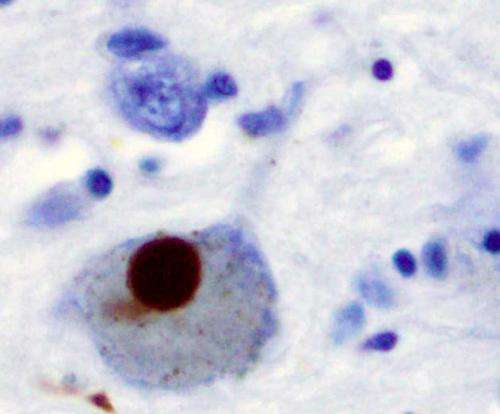Scientists identify metabolic link between aging, Parkinson's

(Medical Xpress)—University of Alabama researchers identified within animal models an enzyme that links genetic pathways that control aging with the death of dopamine neurons – a clinical hallmark of Parkinson's disease.
Further study is needed, but the enzyme could later prove a target, the scientists said, for boosting efforts to prevent or reduce problems associated with the malfunction of dopamine-producing neurons in the brains of diseased patients.
"Discerning metabolic factors that maintain the health of cells from those that make an animal live longer has remained an elusive goal," said Dr. Guy Caldwell, UA professor of biological sciences and the paper's principal author. "This is a step in that direction."
The research shows the "molecular intersection" where aging-associated degeneration and neurodegenerative diseases, like Parkinson's, meet, said Caldwell.
Scheduled for publication in the July 1 issue of Cell Metabolism, the findings show that a gene the scientists discovered to be "neuroprotective" also codes for a basic enzyme in the breakdown of glucose, in the pathway of glycolysis. Glycolysis is the primary cellular pathway by which cells break down sugar to generate energy.
Fourteen of the paper's 17 co-authors, including Drs. Janis O'Donnell and Kim Caldwell, professors of biological sciences, are, or were at the time of the study, affiliated with UA, including multiple undergraduate students.
Adam Knight, a two-time UA graduate now pursuing a doctorate at the University of Cambridge, is the lead author. Dr. Xioahui Yan, a UA post-doctoral scientist, and current UA doctoral students, Siyuan Zhang and Rami Ajjuri, were also key contributors.
Research results were drawn from UA lab animal models including nematodes, worms known as C. elegans, as well as fruit flies, known as Drosophila melanogaster. Additional tests were conducted by collaborators at Harvard University who used neurons isolated from the brains of mice to corroborate the UA findings.
The six-year study began, Caldwell said, by accumulating a list of 625 genes that previous research had shown were involved in both aging and molecular problems associated with Parkinson's.
Through a multi-tiered screening process, researchers in the Caldwell lab identified several genetic factors that exhibited a functional effect in the worms, but then homed in on what would become the targeted enzyme, known as GPI-1, or glucose-6-phosphate isomerase. This enzyme has a well established role in the process of glycolysis.
When researchers in O'Donnell's lab used genetic and biochemical techniques to make this enzyme inoperable in fruit flies, the flies' abilities to move were hampered and their neurons in their brains were more easily damaged.
"Nematodes and fruit flies are very different," O'Donnell said, "so the discovery of this connection between neuron health and this enzyme in both organisms, as well as in mouse neurons, is very exciting because it tells us that we've detected is likely to be important in our brains as well."
As average life spans, and the percentage of elderly, both increase, it becomes increasingly important, Caldwell said, to seek measures that could potentially help those extended years become healthier ones.
"Research can help us distinguish between things that keep our neurons healthy versus things that simply keep us alive," he said. "That distinction between life span and health span is becoming increasingly important as our population ages."
The project also further validated the use of animal model systems to more quickly focus on potential therapeutic targets.
"It shows how we can narrow down those growing lists of genetic modifiers that are being found in patient populations and find the ones that functionally matter to neuron survival," Caldwell said.
The research, funded by National Institutes of Health grants to both Caldwell and O'Donnell, also provided UA students an opportunity to positively impact their professional futures.
"It highlights how undergraduate researchers can play a substantial role in major biomedical research," Caldwell said. Undergraduate co-authors were funded through a grant from the Howard Hughes Medical Institute and via donations from Parkinson's patient support groups in Huntsville and Birmingham.














